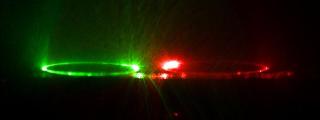Dec 9 2014
The same research team that developed the first laser based on a living cell has shown that use of fluorescent proteins in a solid form rather than in solution greatly increases the intensity of light produced, an accomplishment that takes advantage of natural protein structures surrounding the light-emitting portions of the protein molecules.
 Molecules of green and red fluorescent proteins, which self-assemble into ring-shaped structures under the right conditions, can be stimulated to emit laser light. Credit: Massachusetts General Hospital/University of St. Andrews
Molecules of green and red fluorescent proteins, which self-assemble into ring-shaped structures under the right conditions, can be stimulated to emit laser light. Credit: Massachusetts General Hospital/University of St. Andrews
The findings from investigators Seok Hyun Yun, PhD, of the Wellman Center for Photomedicine at Massachusetts General Hospital and Malte Gather, PhD, of the University of St. Andrews in the U.K. appear in the online journal Nature Communications.
"We found that the size and shape of fluorescent proteins are such that their brightness is at the maximum when they are in their most concentrated form," says Yun. "It is almost as if, through millions of years of biological evolution, Nature optimized these proteins for maximal brightness. Now we have harnessed this property to develop several miniature solid-state lasers."
"Beyond directly using biologically produced fluorescent proteins, studying how they manage to generate light so efficiently at high concentration can guide the design of future, more efficient synthetic materials," adds Gather.
In a 2011 paper published in Nature Photonics, Yun and Gather described using a single cell genetically engineered to express green fluorescent protein (GFP) to amplify the light particles called photons into brief pulses of laser light. Within living cells, fluorescent protein molecules are surrounded by water molecules and other proteins, so their concentration is limited. The current study was designed to investigate the development of a laser based on fluorescent proteins in a solid state, which would be easier to incorporate into other devices.
The portion of a fluorescent protein molecule that actually emits light - called a fluorophore - is enclosed in a cylindrical protein structure that keeps the fluorophores of adjacent molecules from getting too close to each other, which would reduce the amount of light lost to a phenomenon called quenching. To investigate their hypothesis that these structural features prevent quenching in naturally occurring fluorescent proteins, even at the highest concentrations, the researchers measured the intensity of light emitted by GFP solutions of varying concentrations and by a thin film of dried GFP, and comparing those results with the light produced by an artificial fluorescent dye.
While at lower concentrations increasing the levels of both GFP and the dye produced increasing fluorescence, at a certain point the amount of light emitted by the artificial dye began to drop off until no light was detectable from the solid form of the dye. In contrast, the fluorescence of GFP continued to intensify with higher concentrations and maximum brightness was achieved by the solid form, supporting the theory that the fluorophores of GFP and other natural proteins are protected against quenching.
With this evidence that a solid form of GFP produces the brightest light, the investigators first constructed a laser device in which a thin film of dried GFP is sandwiched between two highly reflective mirrors. Compared with devices utilizing lower concentrations of GFP in solution, the solid-state GFP laser required 10 times less excitation energy to start lasing.
Another device took advantage of the "coffee-stain effect," in which material dissolved in solution is deposited in a ring around the edge of a drop as it dries. The team's experiments revealed that the light emitted by the protein molecules within microscopic rings formed by dried droplets of a fluorescent protein is amplified as it circulates around the ring, leading to production of laser light. Putting rings of different types of fluorescent proteins close together enabled the investigators to realize multi-color laser emission. Changes in the humidity of the environment of the protein rings changes the intensity of light emitted, indicating that devices based on the effect could be used as sensors.
"This GFP ring laser is the first laser made entirely of proteins," says Yun. "In the future biocompatible lasers may be implanted in the body or embedded inside tissues to enable optical sensing of the molecular and physical environment, stimulation of cells or activation of light-sensitive drugs."